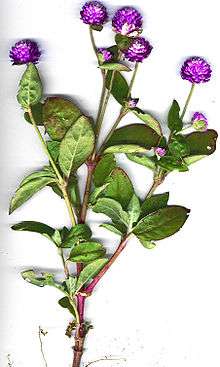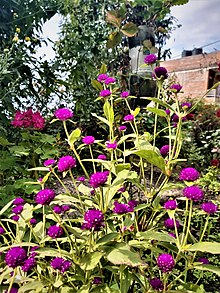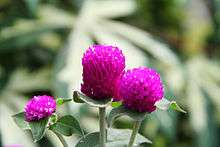Gomphrena globosa
Gomphrena globosa, commonly known as globe amaranth, makhmali, and vadamalli, is an edible plant from the family Amaranthaceae. The round-shaped flower inflorescences are a visually dominant feature and cultivars have been propagated to exhibit shades of magenta, purple, red, orange, white, pink, and lilac. Within the flowerheads, the true flowers are small and inconspicuous.[1]
| Gomphrena globosa | |
|---|---|
 | |
| Purple globe amaranth | |
| Scientific classification | |
| Kingdom: | Plantae |
| Clade: | Tracheophytes |
| Clade: | Angiosperms |
| Clade: | Eudicots |
| Order: | Caryophyllales |
| Family: | Amaranthaceae |
| Genus: | Gomphrena |
| Species: | G. globosa |
| Binomial name | |
| Gomphrena globosa | |

Gomphrena globosa is native to Central America including regions Panama, and Guatemala, but is now grown globally.[2] As a tropical annual plant, G. globosa blooms continuously throughout summer and early fall. It is very heat tolerant and fairly drought resistant, but grows best in full sun and regular moisture.[3] The plant fixes carbon through the C4 pathway.[4] At maturity, the flowerheads are approximately 4 cm long and the plant grows up to 24 inches in height.[1]
Gomphrena globosa is an outcrossing species that is pollinated by butterflies, bees, and other insects. Floral volatiles likely play a significant role in the reproductive success of the plant by promoting the attraction of pollinators.[1]
Uses
In Hawaii, it is commonly used in long-lasting leis since it retains its shape and color after drying. In Nepal, the flower also known commonly as "makhamali ful" is used to make a garland during Bhai Tika, last day of Tihar. The garland is put around the brother's neck by their sister for protection.
This plant is popular in landscape design and cutting gardens for its vivid colors and color retention.
The edible plant G. globosa has been used in herbal medicine. In Trinidad, the flowers are boiled to make a tea which is used for baby gripe, oliguria, cough and diabetes.[5] Caribbean folk medicine historically used globe amaranth to relieve prostate and reproductive problems.[6] The purple inflorescences have been used as a remedy for several respiratory inflammation conditions including bronchial asthma, acute and chronic bronchitis, and whooping cough.[3] Recommended uses in traditional medicine range from the treatment of respiratory diseases, jaundice, urinary system conditions, and kidney problems.[2] Manuscripts dating back to the 1870s ascribe beneficial properties to Gomphrena roots, specifically for digestive and respiratory tract issues as well as the ability to act as a stimulant.[7]
The flowers of G. globosa are rich in betacyanins which have a wide range of applications as additives and supplements in the food industry, cosmetics, and livestock feed. Stable between pH 3 and 7, the betacyanins in globe amaranth are well suited to be used as natural food dye and have a red-violet color.[8]
Additionally, betacyanins have displayed interesting medicinal characteristics as powerful antioxidant and chemopreventive compounds in both in vitro and in vivo models. G. globosa inflorescences extract decreased nitric oxide content in cultured macrophages.[8]

Chemical properties
Phytochemicals
At least twenty-seven phytochemicals have been detected in G. globosa including six phenolic acid derivatives and fifteen specific flavonoids. The most abundant phenolic compounds present are flavonoids. A major phenol was found to be kaempferol 3-O-rutinoside based on chromatographic and mass spectrometry techniques.[2] Gomphrenol derivatives also contribute to phenolic content. Other flavonols include quercetin, kaempferol, and isorhamnetin derivatives.[3]
Betacyanins
The major betacyanins identified in globe amaranth are gomphrenin, isogomphrenin II, and isogomphrenin III.[2] These compounds are stored in vacuoles in the plant.[9]
Volatiles
Cultivars of G. globosa vary in the identity of floral volatiles but the volatile compounds of nonanal, decanal, geranyl acetone, and 4,8,12-tetradecatrienal, 5,9,13-trimethyl, were commonly detected by chromatography-mass spectrometry analysis. The cultivar ‘Fireworks’ has a high abundance of volatile esters such as geranyl propionate, geranyl isovalerate, benzyl isovalerate, and benzyl tiglate. The floral volatile emission of this cultivar of G. globosa was found to exhibit a diurnal pattern independent of light. Emission of floral volatiles can be regulated by phytohormone and defense signaling molecules. Experimentally, the ethylene inhibitor silver thiosulphate increased volatile emission of molecules derived from the terpenoid pathway. Defense signaling molecules can have temporal effects on floral volatile emission such as increased emission after four hours and reduced emission of volatiles after 24 hours in time studies analyzed with chromatography-mass spectrometry.[1]
References
- Jiang, Yifan; Zhao, Nan; Wang, Fei; Chen, Feng (2011-01-01). "Emission and Regulation of Volatile Chemicals from Globe Amaranth Flowers". Journal of the American Society for Horticultural Science. 136 (1): 16–22. doi:10.21273/JASHS.136.1.16. ISSN 0003-1062.
- Roriz, Custódio Lobo; Barros, Lillian; Carvalho, Ana Maria; Santos-Buelga, Celestino; Ferreira, Isabel C.F.R. (2014). "Pterospartum tridentatum, Gomphrena globosa and Cymbopogon citratus: A phytochemical study focused on antioxidant compounds" (PDF). Food Research International. 62: 684–693. doi:10.1016/j.foodres.2014.04.036. hdl:10198/10145.
- Silva, Luís R.; Valentão, Patrícia; Faria, Joana; Ferreres, Federico; Sousa, Carla; Gil-Izquierdo, Angel; Pinho, Brígida R.; Andrade, Paula B. (2012). "Phytochemical investigations and biological potential screening with cellular and non-cellular models of globe amaranth (Gomphrena globosaL.) inflorescences". Food Chemistry. 135 (2): 756–763. doi:10.1016/j.foodchem.2012.05.015. PMID 22868155.
- Herold, A.; Lewis, D. H.; Walker, D. A. (1976-05-01). "Sequestration of Cytoplasmic Orthophosphate by Mannose and Its Differential Effect on Photosynthetic Starch Synthesis in C3 and C4 Species". New Phytologist. 76 (3): 397–407. doi:10.1111/j.1469-8137.1976.tb01475.x. ISSN 1469-8137.
- Mendes, John (1986). Cote ce Cote la: Trinidad & Tobago Dictionary. Arima, Trinidad. p. 7.
- Lans, Cheryl (2007-03-15). "Ethnomedicines used in Trinidad and Tobago for reproductive problems". Journal of Ethnobiology and Ethnomedicine. 3: 13. doi:10.1186/1746-4269-3-13. ISSN 1746-4269. PMC 1838898. PMID 17362507.
- S., Bajaj, Y. P. (1994). Medicinal and Aromatic Plants VI. Berlin, Heidelberg: Springer Berlin Heidelberg. ISBN 9783662303719. OCLC 840292441.
- Roriz, Custódio Lobo; Barros, Lillian; Prieto, M.A.; Morales, Patricia; Ferreira, Isabel C.F.R. (2017). "Floral parts of Gomphrena globosa L. as a novel alternative source of betacyanins: Optimization of the extraction using response surface methodology" (PDF). Food Chemistry. 229: 223–234. doi:10.1016/j.foodchem.2017.02.073. hdl:10198/14894. PMID 28372168.
- Tanaka, Yoshikazu; Sasaki, Nobuhiro; Ohmiya, Akemi (2008-05-01). "Biosynthesis of plant pigments: anthocyanins, betalains and carotenoids". The Plant Journal. 54 (4): 733–749. doi:10.1111/j.1365-313X.2008.03447.x. ISSN 1365-313X. PMID 18476875.